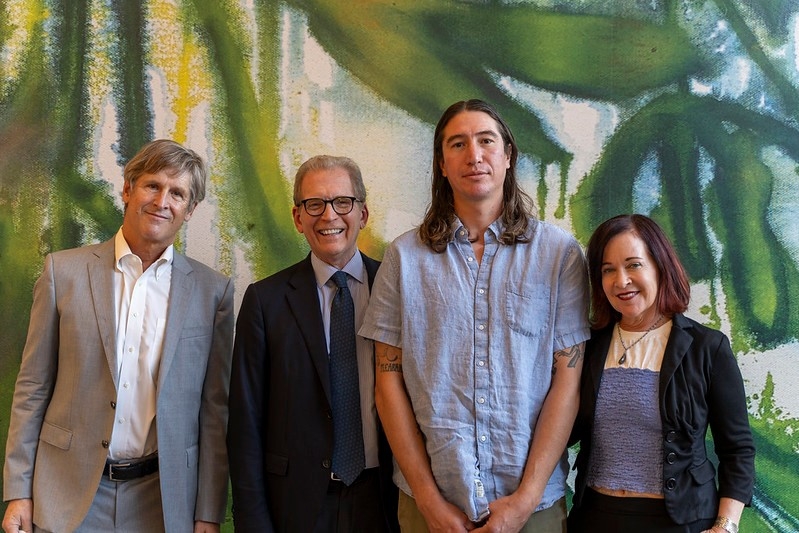On Oct. 2, 2024, Stanford University School of Medicine unveiled Rooted in the Land, a monumental art installation at Stanford Research Park (SRP) honoring the medicinal traditions of the Muwekma Ohlone, the original inhabitants of the land where the university now stands. Created by Libyan-Yurok artist Saif Azzuz, the installation celebrates the native plants of the Bay Area and reflects on the enduring relationship between land, people, and the advancement of biomedical science.
The ceremony brought together researchers, administrators, and artists, marking Stanford’s deep commitment to acknowledging and celebrating the land’s original stewards. In his opening remarks, Lloyd B. Minor, MD, dean of the School of Medicine and vice president for medical affairs at Stanford University, emphasized, “Of great importance to the Ohlone people, and consistent with our values of community and inclusion, we have a responsibility to acknowledge, honor, and make visible the university’s relationship to Native peoples.”
The installation consists of seven large-scale representations of native plants such as Híišen (mugwort), Miryan (California sagebrush), and Rawwen (soap plant), all of which hold medicinal significance for the Ohlone people. These plants serve as a reminder of the deep knowledge Indigenous communities have cultivated about the environment and how this wisdom continues to inform contemporary science and healing practices.
What started as a building-naming initiative evolved into a meaningful way to honor the land’s original inhabitants and their traditions. ”Promila RastogiDirector of Transition Strategies & SRP Operations
Visitors entering the building are greeted by a breathtaking, monumental vinyl painting of these native plants, bathed in warm, earthy tones. As sunlight streams through the windows, it illuminates the artwork, amplifying its vibrant energy and inviting viewers to connect with the land’s deep history. “This work connects the original inhabitants of the land to the important medical research happening here at SRP,” said Minor. “What was once a blank wall is now a vibrant work of art, which hundreds will enjoy as they come here for research, education, and meetings.”
Building a sense of place: naming Miryan Hall
For Stanford, this installation goes beyond art – it serves as a catalyst for building community among researchers at SRP. In addition to the art installation, the School of Medicine has adopted a naming system for its buildings that honors the medicinal plants used by the Ohlone people. The building housing Azzuz’s work will now be known as Miryan Hall, named after the California sagebrush, traditionally used to treat wounds and respiratory ailments.
“The installation of Rooted in the Land culminates years of efforts to foster connection and cohesiveness among the School of Medicine community at SRP,” shared Promila Rastogi, Director of Transition Strategies & SRP Operations. “What started as a building-naming initiative evolved into a meaningful way to honor the land’s original inhabitants and their traditions. This art installation is something I hope brings joy to everyone who sees it.”
Mark Nicolls, a key figure in SRP’s planning and community-building efforts, emphasized the significance of the project. "The art and the building names are more than symbolic gestures; they help strengthen the sense of community at SRP. As a lung doctor with a lab nearby, I can see how the efforts to connect our work with the land and its history enhance the environment here. It’s exciting to see SRP evolving in such meaningful ways.”

From left: Mark Nicolls, Dean Minor, Saif Azzuz, and Deborah Cullinan at “Rooted in the Land.” | Clinton Louie
About the artist
Saif Azzuz, a Libyan-Yurok artist based in Pacifica, California, is known for his work exploring the interconnectedness between people and nature. His art often focuses on ecological resilience and the need to view land as a living entity rather than a resource.
“Traditionally, settlers viewed the land as something to be conquered, while Indigenous peoples view it as a relative to be nurtured and protected,” Azzuz explained. “My artistic practice is rooted in our interconnection with each other and the land. This work celebrates Indigenous ecological knowledge, stewardship, and resilience.”
Azzuz’s pieces for Rooted in the Land include both large-scale vinyl paintings and smaller acrylic works on paper, each representing a native plant traditionally used by the Ohlone for healing and ceremony. His titles incorporate words from the Yurok and Ohlone languages, reflecting his dedication to preserving Indigenous culture. He also highlighted the overlap in medicinal plants used by the Yurok and Ohlone, emphasizing shared knowledge across Indigenous communities.
Honoring the past, inspiring the future
The event concluded with words from Azzuz, who expressed his gratitude for contributing to Stanford’s efforts to honor Indigenous history. “I want to thank the original stewards of the land: the Ramaytush, Tamien, and Muwekma Ohlone peoples, who continue to fight for their ancestral lands and federal recognition,” Azzuz said. “I’m honored to have my art serve as a backdrop to the meaningful work being done here.”
Through the thoughtful integration of Indigenous traditions and modern science, SRP continues to build a future that is innovative yet deeply rooted in the land.
For more information
This story was originally published by the Department of Medicine.